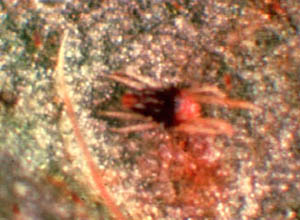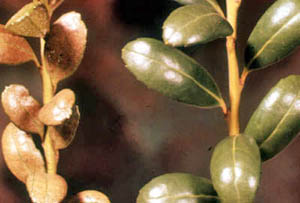Southern Red Mite (Oligonychus ilicis)


Adults are ½ mm long, oval, purplish, or reddish, with eight legs. The red eggs overwinter on the undersides of leaves. There are several generations each year. Most activity occurs in spring and fall.
This imported spider mite has a wide host range, but prefers broad-leaved evergreens in the Ericaceae and Aquifoliaceae. It is common on azalea, rhododendron, mountain laurel, holly, rose, viburnum, firethorn, and yew.
Examine plants closely for signs of stippling and the various mite stages on the lower and upper leaf surfaces of broadleaved evergreens in early spring and the fall. When stippling is noticed, tap leaves over white paper to dislodge and count mites, as well as the beneficial insects and predaceous mites. Predaceous mites have longer legs than the southern red mite and move much faster. Look for red overwintering eggs on the lower surface of leaves from November through early spring.
Application of a dormant oil to the lower surface of leaves when overwintering eggs are numerous will help reduce spring populations. In light infestations, the use of a horticultural oil or insecticidal soap will control these mites with minimal impact on beneficial organisms. When heavy infestations of mites are present, the application of residual miticides often is necessary.
